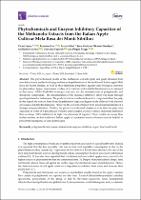Por favor, use este identificador para citar o enlazar este ítem:
https://repositorio.usj.es/handle/123456789/398
| Título : | Phytochemicals and enzyme inhibitory capacities of the methanolic extracts from the italian apple cultivar mela rosa dei monti sibillini |
| Autor: | López Ramos, Víctor


Les Parellada, Francisco 

Mevi, Serena 
Wandjou, Joice Guileine Nkuimi 
Cásedas, Guillermo 

Caprioli, Giovanni 


Maggi, Filippo 
|
| Palabras clave : | Polifenoles; Triterpenos; Antioxidantes inhibidores de enzimas; Manzana; Alimentos funcionales |
| Fecha de publicación: | 22-jun-2020 |
| Editorial : | MDPI AG |
| Citación : | López, V.; Les, F.; Mevi, S.; Nkuimi Wandjou, J.G.; Cásedas, G.; Caprioli, G.; Maggi, F. Phytochemicals and Enzyme Inhibitory Capacities of the Methanolic Extracts from the Italian Apple Cultivar Mela Rosa dei Monti Sibillini. Pharmaceuticals 2020, 13, 127. |
| Descripción : | The phytochemical profile of the methanolic extracts (pulp and peel) obtained from two dehydration methods (drying and freeze-lyophilization) of the traditional Italian apple Mela Rosa dei Monti Sibillini, as well as their inhibitory properties against some biological enzymes (α-glucosidase, lipase, monoamine oxidase A, tyrosinase and acetylcholinesterase) were assessed in this study. HPLC-DAD-MS technique was used for the determination of polyphenolic and triterpenic compounds. The determination of the enzymes inhibitory effect was made through spectrophotometric techniques. The peel extracts were richer in bioactive compounds than the pulp. In this regard, the extracts from freeze-lyophilization displayed higher levels of flavan-3-ols, flavonol glycosides and dihydrochalcones. However, the extracts obtained from dried material displayed a stronger enzyme inhibition. Notably, the peel extracts showed a higher activity than the pulp ones, especially in terms of α-glucosidase whereby some samples exerted a similar enzymatic inhibition than acarbose (100% inhibition) at high concentrations (1 mg/mL). These results encourage thus further studies on this traditional Italian apple as a potential source of nutraceuticals helpful to prevent the insurgence of some pathologies. |
| URI : | https://repositorio.usj.es/handle/123456789/398 |
| ISSN : | 1424-8247 |
| Aparece en las colecciones: | Artículos de revistas |
Ficheros en este ítem:
| Fichero | Descripción | Tamaño | Formato | |
|---|---|---|---|---|
| Phytochemicals and enzyme inhibitory capacities of the methanolic extracts from the italian apple cultivar mela rosa dei monti sibillini.pdf | 1,41 MB | Adobe PDF |  Visualizar/Abrir |
Este ítem está sujeto a una licencia Creative Commons Licencia Creative Commons

